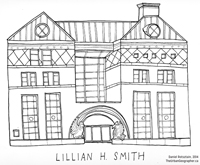
"The love for a good story, well told, lies deep in every human heart." - Lillian H. Smith
One hundred years ago this year, in 1912, in response to increasing demand for children's services, Toronto Public Library Chief Librarian George Locke recruited Lillian H. Smith to head a new Children's Department. Born in London, Ontario, Smith was the first professionally trained children's librarian in the British Empire, and had worked for about a year in the Washington Heights Branch of the New York Public Library.
Smith was 25 when she came to Toronto Public Library, and with boundless energy and enthusiasm, she immediately started to improve collections, train staff and expand programs. By the end of her 40 years of innovative leadership, children's services were available in 16 branch libraries, 30 schools and two settlement houses, as well as at the flagship Boys and Girls House, opened on St. George Street in 1922. She also introduced story hours that frequently attracted audiences of more than 100 children in the 1920s and 1930s. Under Smith's guidance, reading clubs were organized for older children, and children staged plays and puppet shows, held debates, and discussed literary and historical subjects.
Lillian H. Smith believed that the role of the children's librarian was to deliver "the right book, to the right child, at the right time." She edited Books for Boys and Girls, first issued by Toronto Public Library in 1927, which became an indispensible guide for libraries across Canada and beyond. In 1953 the American Library Association published her seminal book, The Unreluctant Years: A Critical Approach to Children's Literature. She lectured at the University of Toronto from 1913 to 1952, and was instrumental in forming the Canadian Association of Children's Librarians (which predated the Canadian Library Association).
Lillian H. Smith Branch Story Project
This site features stories about Toronto Public Libary's Lillian H. Smith Branch and the old Boys and Girls House, and their surrounding communities.





